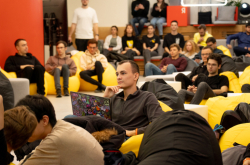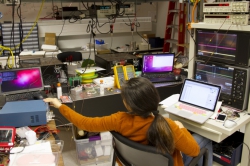The outdoor hacker conference has been held in the Netherlands every four years since 1989, yet, despite the event’s lengthy conference, it still does not have a permanent name: each installment of the five-day convention gets a new name. This year’s SHA2017 (Still Hacking Anyway) follows such events as the GHP1989 (Galactic Hacker Party), WTH2005 (What The Hack), HAR2009 (Hacking At Random) and others.
“Most people who come here use the word “hacker” in its original sense: a sort of a synonym for “explorer”, but leaning a bit more towards information security. The participants can be better described as researchers, driven by curiosity, intent on understanding how a particular system functions,deconstructing it and, perhaps, making it do things it wasn’t able to do before,” – explains Oleg Zaytsev.

SHA2017's camp area.
This is no small-scale event. Long before the event began, four thousand entrance tickets were pre-ordered. Approximately a 1000 volunteers were employed; one such volunteer was Oleg himself, who helped escort the guests to the camp area. The camp is organized by members of the international hacking community. Developers from all around the world come to events like this, most of them experts in information security. Here, they can share their experience, knowledge, experiments and get to know each other in an informal environment. They sleep, hack and have fun side by side – anyone can pitch a tent where they prefer to and “dig in” for the rest of their stay at the camp.
“I’ve been meaning to come here since 2001 after I read about this conference in a magazine. Information security has been an interest of mine since childhood, and I’ve stayed true to that wish for a long time. I’m very impressed. Anyone can find something to their liking here: those who want to learn can attend any of the lectures that start at 10AM and end at midnight, while those who want to hack and party can come to the nightly mixers,” – he shares.

Guests at the events, meanwhile, hacked everything they could. A hacker crew from Italy, for example, poked around with some of the camp’s official infrastructure – more precisely, the lighting installations set up around the premises. Having hacked into the system, the Italians reprogrammed the lamps and diodes to display the Italian flag.
The camp’s territory was split into several zones, each named after scientists and others who have had an influence on the field of information security (one of the zones, for example, is named after Edward Snowden). Everyone can place their tents wherever they want, although many guests organized makeshift “villages” with large tents where they could conduct their own events. In other words, in addition to the main program developed by the event’s organizers, everyone could offer their own activities. You can see the list of the projects here.

Workshops of all kinds were organized, not just on information security, but on many other unrelated topics; one of them, for instance, was a ring-smithing workshop. Lectures touched upon not only the practical aspects of hacking, but ethics, too. The topic of freedom of speech on the internet was discussed heavily – independent observers point out with increasing frequency that freedom of speech is becoming less available in the world. In its 2016 report, Reporters Without Borders describe an “"climate of fear and tension combined with increasing control over newsrooms by governments and private-sector interests”. The Silent Protest project was presented at the festival: a wearable DIY protest network build of inexpensive network gear and open source software. Its goal is to facilitate freedom of speech, enable art sharing in countries where this human right is being challenged by authorities, and offer a customizable portable Anonymous Protest Network platform reliable and affordable enough to be built in third world countries and developed countries alike.

Another hot topic of discussion among the hackers was the issue of data in the context of increasing influence of major internet companies. By accumulating user data, IT giants become more and more powerful both online and in real life, with political and economic systems becoming dependent on them. Upholding human rights becomes more difficult, which is why programmers are concerned with privacy and digital authorization of uses: how can technology be used to ensure a digital freedom?
Hackers also discussed security and privacy of artificial intelligence and machine learning, and quantum network creation. Another relevant topic is the electoral system. Using the Dutch election system as an example, one of the speakers explained how vulnerabilities can be exploited to adjust election results in ways unintended by the state.

The Human Rights Foundation’s North Korea Program held a presentation for SHA2017 attendees about fighting total government control using informational technology: USB-drives, DVD disks and shortwave radio. The program uses these means to help promote freedom of thought in North Korea.
The camp area is situated next to a lake, so, near the end of the event, programmers had organized a competition, or, to be exact, a makeshift boat race. Participants were timed and had to swim a distance of 25 meters on self-made boats made of duct tape and cardboard.

According to Oleg Zaytsev, hacker meet-ups differ from others by their conversation topics; still, there is a place for a layman’s concept of a “hacker”. As the sun set on the camp, the area slowly filled up with people wrapped in LED-lights, wearing costumes inspired by the classic Hollywood image of a hacker. Of course, Anonymous masks were prevalent, too – although they were mostly worn by children.
“The connection was magical! In my tent I didn’t even have electricity, yet the download speed was 31 times higher than in my St. Petersburg flat and the upload speed a whole 120 times higher! The organizers had set up a great broadband connection – there were 10 Gb Ethernet switches everywhere. Every participant had their own external IP, which made communication really simple,” – shares Oleg.

Oleg Zaytsev (center). Credit: social media
Another source of entertainment was the central bar, where a large display hung behind the bartenders. Each pixel of it could be modified by sending a message containing the corresponding X and Y coordinates and color to the screen – send enough packages and you can make a drawing. As this function was accessible to all, the images soon began to compete with each other as players vied for the same pixels. The broadband came in handy then, says Zaytsev, although with just one laptop and a Wi-Fi connection, the best one could do was draw a 16x12 pixel image – the Master’s student managed to display a small green running monster.
All photos in the article are credit to flickr.com/photos/waagsociety unless otherwise stated





